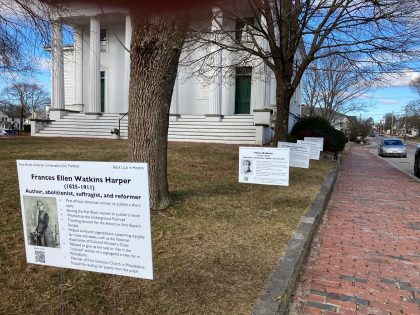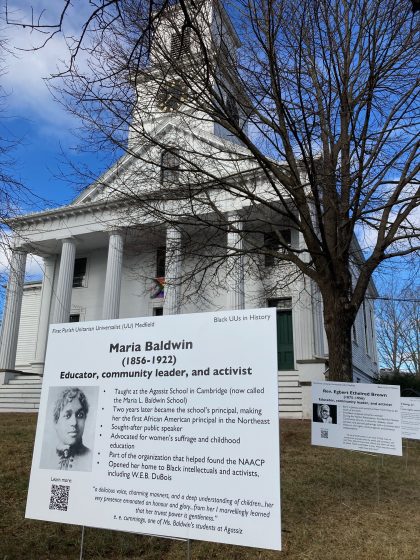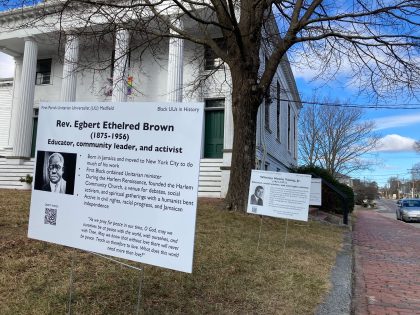Black UUs in History
   |
Frances Ellen Watkins Harper (1825-1911) was the first African American woman to publish a short story, and among the first Black women to publish a novel. In addition, she was an influential abolitionist, suffragist, and reformer. Harper felt at home with the Unitarian religious beliefs and knew that her work could strengthen the justice work of the Unitarians. She joined the First Unitarian Church in Philadelphia in 1870. She frequently read her poetry from the pulpit at this church, yet she kept her membership and taught Sunday school at an AME church, too.
Sources
https://en.wikipedia.org/wiki/Frances_Harper
https://www.womenshistory.org/education-resources/biographies/frances-ellen-watkins-harper
https://www.poetryfoundation.org/poets/frances-ellen-watkins-harper
Dr. Mtangulizi Sanyika (aka Hayward Henry) chaired the Black Unitarian Universalist Caucus (BUUC), a Black Power organization within the Unitarian Universalist Association. He advocated for the UUA to dedicate one million dollars to a Black Affairs Council. Initially his efforts were successful, but the UUA’s board of trustees began to renege on their financial commitment and only a portion of the money was disbursed. A mass exodus of deeply disappointed Black Unitarian Universalists ensued. The funds dispersed allowed Dr. Sanyika to invest in initiatives that empowered Black communities across the nation and connected Black communities throughout the world: getting Kwaanza celebration recognized and producing “Eyes on the Prize,” which traced the civil rights movement from the Black perspective. He helped form the Congress of African people to empower the international Black community.
Sources:
https://www.uuworld.org/articles/black-hole-white-uu-psyche
Maria Baldwin (1856-1922) was an educator, community leader, and activist. She was born in Cambridge soon after Massachusetts public schools were desegregated. Trained as an educator, she first looked to teach locally but was not initially hired by Cambridge public schools. Instead, she began her teaching in a segregated school in Maryland. Only after protests from the African American community was she finally hired by the Agassiz school. Two years later she became that school’s principal, leading an all-white faculty and a primarily white student body (mostly children of old Cambridge families and Harvard professors) and making her the first African American principal in the Northeast. She continued teaching and leading the school throughout her life; during her tenure, Agassiz was considered one of the best schools in the city. Among her students was poet E.E. Cummings, who described her in glowing terms: “a delicious voice, charming manners, and a deep understanding of children…her very presence emanated an honour and glory…from her I marvellingly learned that her truest power is gentleness.” The school was renamed the Maria L. Baldwin School in 2004.
Baldwin often spoke publicly. She was the first African American and the first woman to be asked to speak at the annual Washington’s Birthday celebration at the Brooklyn Institute of Arts, at which she spoke about Harriet Beecher Stowe.
She was a member of and often in a leadership position with many influential groups and organizations:
· Member and Secretary of the Banneker Society, an African American debate club, advocating for women’s suffrage and childhood education
· Co-founder of the Women’s Era Club, which focused on the anti-lynching movement, women’s suffrage, and opportunities in education and employment; this organization published “The Woman’s Era,” the first periodical published by Black women
· Member of the Committee of Forty which organized the founding of the NAACP, and later a member of the board of the Boston branch of the NAACP
· President of the League of Women for Community Service of Roxbury/Boston, which was initially founded to provide comfort and support to returning soldiers and bereaved widows during World War I; it later shifted toward providing educational and social services to the local community
· Member of several white-dominated organizations as well
Baldwin opened her home to Black intellectuals and activists, providing them with a safe space to share and be together. She led a literary group for Black Harvard students, including W.E.B. DuBois, who described her in the following way: “Miss Baldwin, thus without doubt, occupies the most distinguished position achieved by a person of Negro descent in the teaching world of America, outside cities where there are segregated schools.”
Sources
https://www.nps.gov/people/maria-l-baldwin.htm
https://en.wikipedia.org/wiki/Maria_Louise_Baldwin
https://historycambridge.org/articles/maria-baldwin-1856-1922-an-honor-and-a-glory/
Rev. Egbert Ethelred Brown (1875-1956) was born in Jamaica. He was gifted in mathematics and became an accountant through the Civil Service of Jamaica. He did this work for over ten years during which time he married and started a family.
In childhood, Ethelred (the name he was known by) was raised in the Anglican church. He discovered Unitarianism through a pamphlet he found in his uncle’s home. The theology resonated with him, although there were no Unitarian congregations in Jamaica. When he lost his job with civil service, he decided to become a Unitarian minister. Ethelred was told he needed to attend a Unitarian school in the U.S. After raising money and traveling to the states twice, he was granted entrance to the Meadville Theological School in Pennsylvania in 1910 and in 1912, became the first Black ordained Unitarian minister. Back in Jamaica, Rev. Brown hoped to establish Unitarianism there. He worked and preached for eight years, despite the American Unitarian Association’s withdrawal of financial support in 1915.
In 1920, Rev. Brown moved with his wife and four children to Harlem in New York City and founded the Harlem Community Church. This was during a period known as the Harlem Renaissance—a revival of African and Caribbean American art, literature, scholarship, politics, and religion in the 1920’s and 1930’s. Although the Harlem Community Church (later renamed the Hubert Harrison Memorial Church in 1928, and then the Harlem Unitarian Church in 1937) did not attain large membership, Rev. Ethelred Brown was active in civil rights, racial progress, and Jamaican independence. The Harlem Unitarian Church became a venue for numerous debates, social activism, and spiritual gatherings with a humanist bent.
Despite struggles with the American Unitarian Association and finances in general, Rev. Brown did receive a pension at age 65 until his death at age 81 in 1956. That year, the Harlem Unitarian Church dissolved. Brown’s papers are held today by the Schomburg Center for Research in Black Culture, at the New York Public Library.
“As we pray for peace in our time, O God, may we ourselves be at peace with the world, with ourselves, and with Thee. May we know that without love there will never be peace. Teach us therefore to love. What does this world need more than love?” – Rev. Egbert Ethelred Brown, 1875-1956
Sources
https://en.wikipedia.org/wiki/Ethelred_Brown
https://www.uua.org/re/tapestry/children/journeys/session8/finding-your-way
https://jamaica-history.weebly.com/rev-e-e-brown.html
 Whitney Moore Young, Jr. (1921-1971) was an educator, social worker, and civil rights activist. He is probably best known for his years of work in the National Urban League.
Whitney Moore Young, Jr. (1921-1971) was an educator, social worker, and civil rights activist. He is probably best known for his years of work in the National Urban League.
As a young man, while attending college in Kentucky, Young took premedical courses, and then studied engineering for two years at MIT before joining the Army. In 1944, he found himself in World War II Europe in an all-Black regiment with a White captain. Young often found himself mediating between the officer and the troops, bridging racial and cultural gaps and mitigating the tension always present in the situation. In Young’s own words, “It was my Army experience that decided me on getting into the race relations field after the war. Not just because I saw the problems, but because I saw the potentials, too. I grew up with a basic belief in the inherent decency of human beings.”
After the Army, Young finished his degree and went on to graduate school in Minnesota for social work. It was there he first had contact with the Urban League, a longtime advocacy organization that addressed inequities and injustices against African Americans. Young worked at the Minnesota Urban League in St. Paul, and then the Urban League in Omaha, NE. In both cities, he and his family were involved with the Unitarian church as well as an African Methodist Episcopal congregation. They moved to Atlanta in 1954 when Young became Dean of the Atlanta University School of Social Work. As a member of the Atlanta Unitarian Church, he got that congregation to change its practice of holding annual picnics at segregated parks. He fought successfully to desegregate the Atlanta public library system, and co-chaired the Atlanta Council on Human Relations.
In 1961 Young was offered and accepted a job as executive director of the National Urban League. The family moved to New Rochelle, NY. They attended but never joined the White Plains Community Church (Unitarian). However, Young agreed to be elected to the board of the Unitarian Universalist Service Committee in 1961 and in 1963 to be appointed to the UUA Commission on Religion and Race. Young led the National Urban League for ten years during the tumultuous times of the American Civil Rights Movement, expanding its mission, employees, and funding. All the while, Young navigated carefully between advocating for Black organizations and lobbying support from influential White businessmen and politicians. He was an advisor to Presidents Kennedy, Johnson, and Nixon. Young believed that greater government and private-sector efforts were needed to fight poverty and inequity.
Tragically, Whitney Young died in 1971 at age 49 of a heart attack while swimming in Lagos, Nigeria. He had been attending a conference of African leaders. Today, his name is on numerous school buildings and health care centers.
Sources
https://files.meadville.edu/files/resources/young.pdf
http://blackhistorynow.com/whitney-m-young-jr/
https://en.wikipedia.org/wiki/Whitney_Young
